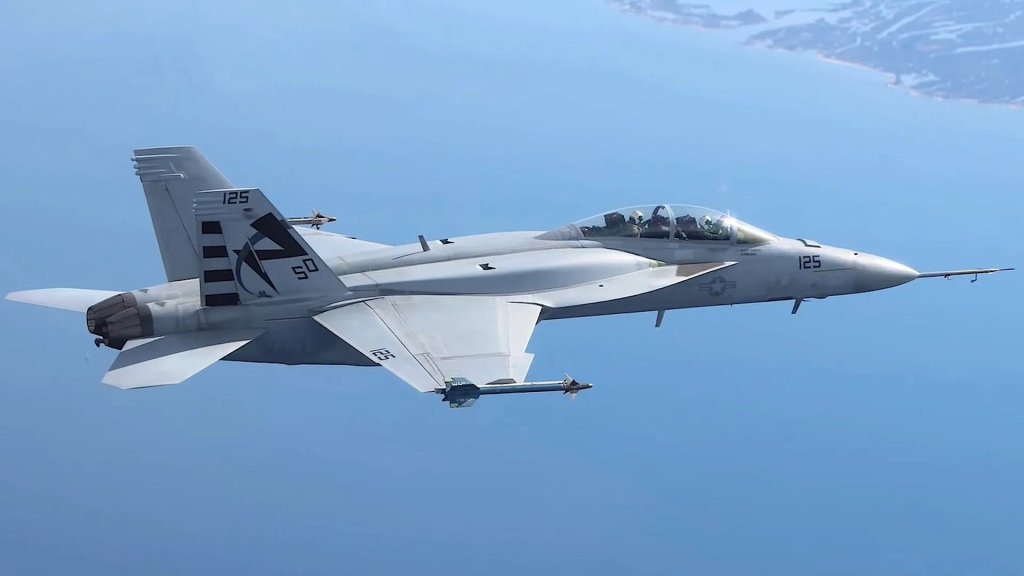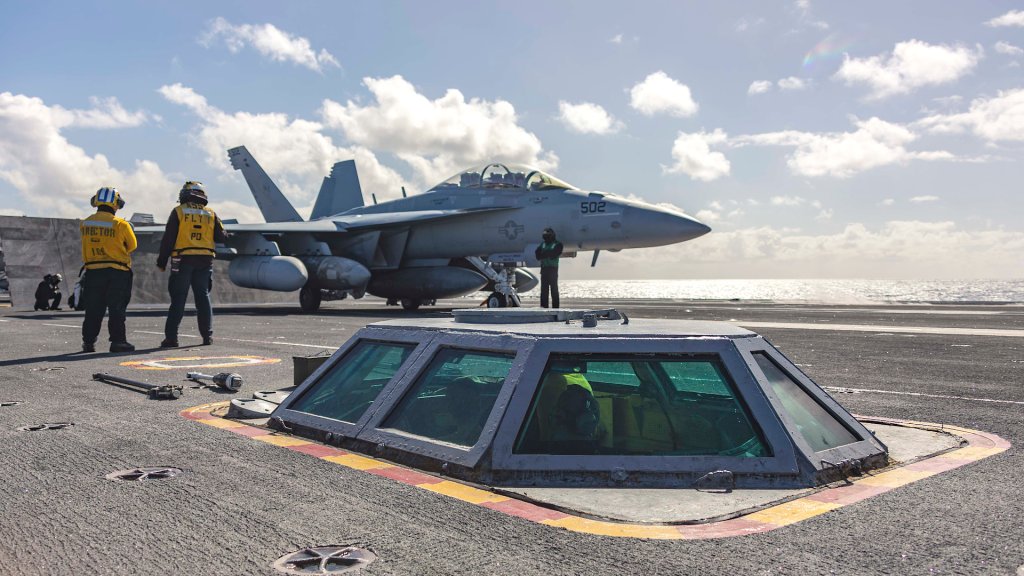The U.S. Navy is asking for new ideas about how to increase the unrefueled range of its F/A-18E/F Super Hornet fighters and EA-18G Growler electronic warfare aircraft. The service axed plans to give its Super Hornets range-extending conformal fuel tanks (CFT) nearly four years ago, citing technical and other issues. The Navy’s MQ-25 Stingray tanker drone program has also experienced significant delays, as well as cost growth.
Naval Air Systems Command (NAVAIR) put out a contracting notice asking for information about potential “innovative concepts” for extending the range of its Super Hornet and Growler fleets earlier today.

“The intent of this RFI [request for information] is to provide… initial insight into the existence of such concepts, their potential capability to extend platform range, how the concept could be integrated into naval TACAIR [tactical aircraft], and any considerations with respect to reliability and suitability for carrier-based flight operations,” the notice says. “It is meant to provide respondents with broad latitude to submit concepts across multiple engineering disciplines that could provide extended range capability.”
“Example areas these concepts may address include, but are NOT limited to, methods to increase lift, reduce drag, increase fuel available, reduce fuel usage on the deck, increase engine performance; and/or adjustments to subsystem integration and/or architecture or advanced flight controls,” it adds.
NAVAIR’s website puts the F/A-18E/F’s maximum combat range at 1,275 nautical miles (2,346 kilometers), but with a loadout of just two AIM-9 Sidewinder air-to-air missiles. Boeing, the Super Hornet’s manufacturer, has said in the past that the jet’s range is around 1,188 nautical miles (2,200 kilometers) when carrying two AIM-9X Sidewinders, two AIM-120 Advanced Medium Range Air-to-Air Missiles (AMRAAM), two 2,000-pound-class precision-guided bombs, and a 480-gallon drop tank on the centerline station.
The EA-18G’s combat range when carrying three AN/ALQ-99 jamming pods, two AIM-120s, two radar-busting AGM-88-series missiles, and two 480-gallon drop tanks is over 850 nautical miles (1,574 kilometers), per NAVAIR.

As already noted, Boeing has developed CFTs for the F/A-18E/F offering greater range and performance over loadouts using traditional draggy drop tanks. The two conformal tanks, designed to be installed on either side of the Super Hornet’s spine on top of the jets’ center “barrel” section, can hold 515 gallons of fuel in total. The company has previously said the tanks could extend the range of Super Hornet loaded with a pair of AIM-9Xs, a pair of AIM-120s, a pair of 2,000-pound precision-guided bombs, and the centerline drop tank, to 1,428 nautical miles (close to 2,645 kilometers). The CFTs could also free up the stations previously taken up by drop tanks for other stores.

The Navy had originally planned to include the CFTs along with other improvements on new-production Block III Super Hornets and older jets brought up to that standard – an upgrade effort that is still underway. There had also been the potential for adding the CFTs to the EA-18Gs down the line.

However, in January 2021, the Navy halted work on the CFTs for the Super Hornet citing, in part, still largely unexplained technical hurdles tied in some way to carrier-based operations, as you can read more about here. Cost growth and delays were also a factor.
It is certainly possible that the Navy could now revisit the matter of CFTs. At least new-production Block III Super Hornets all still have provisions for the ones Boeing has designed already. New, low-drag drop tanks might be another option.

NAVAIR’s mention of “increase engine performance” as another possible avenue to increasing F/A-18E/F and EA-18G range recalls previous discussions about re-engining the jets. An Enhanced Performance Engine (EPE) configuration of the existing General Electric F414s that power Super Hornets and Growlers now has been proposed in the past. The F414-EPE was projected to offer a 20 percent increase in thrust (which could translate to greater range) and a one percent reduction in fuel burn rate.

How cost-effective and otherwise viable any other potential changes to the jet’s physical structures, including the placement of subsystems, another potential range-extending avenue NAVAIR mentioned in its contracting notice today, might be is unclear. The Navy’s existing Super Hornets have already been going through costly and time-consuming life-extension and upgrade programs in recent years. New-production jets are rolling off a line Boeing plans to shutter completely in 2027.
At the same time, relatively small individual efficiency gains from more modest changes, such as vortex generators and drag-reducing techniques, coupled with improved computer-controlled flight systems and new tactics, techniques, and procedures, could all up when it comes to fuel economy and range.
What is clear is that the Navy still has a significant interest in finding on-aircraft ways to extend the range of its F/A-18E/Fs and EA-18Gs. This comes amid an expanding air defense and anti-ship threat ecosystem that presents growing challenges to carrier-based aircraft and the ships in carrier strike groups. China’s ever-more-capable arsenal of air-to-air, surface-to-air, and anti-ship missiles, as well as other anti-access and area-denial capabilities, is of particular concern to the U.S. military. This reality can only contribute to lengthening distances between where carriers will have to launch their aircraft to reduce vulnerability and where those planes are expected to operate.
We have already seen this translate to significant aviation-related developments within the Navy, particularly the development and now fielding on at least a limited level of the AIM-174B air-launched derivative of the multi-purpose Standard Missile-6 (SM-6), which you can read more about here. F/A-18E/Fs are currently the only known launch platform for the notably large, heavy, and draggy AIM-174Bs, underscoring the value of new range-extending option, especially as alternatives to traditional drop tanks. Super Hornets are also set to be at least the initial launch platform for the Navy’s Hypersonic Air-Launched Offensive Anti-Surface Warfare (HALO) hypersonic anti-ship cruise missile, another weapon that is expected to be relatively large. Heavier stores loadouts translate to increased fuel burn, as well as less margin for carrier-based aircraft to bring them back to the ship.

There is also the matter of the Navy’s work to introduce new infrared search and track (IRST) sensors in modified centerline drop tanks with reduced fuel capacity. IRSTs are an increasingly important capability for tactical jet fleets across the U.S. military.
The Navy is also in the process of fielding a new family of next-generation electronic warfare pods for the EA-18G. GAO has reported in the past that Raytheon’s ALQ-249(V)1 Next Generation Jammer-Mid Band (NGJ-MB) pods produce more drag than the existing AN/ALQ-99s and reduce range as a result. Weight and drag issues may also have contributed to the Navy’s decision to choose an entirely separate design for the NGJ-Low Band (NGJ-LB) pod from L3Harris and Northrop Grumman rather than an NGJ-MB-derived proposal from Raytheon.

When it comes to extending the reach of its carrier air wings, the Navy is also still pursuing a fleet of uncrewed MQ-25 Stingray tankers, another Boeing product, to help increase the range of its carrier-based tactical jets. Core requirements for the Stingrays include the ability to offload at least 14,000 pounds of fuel (and potentially up to 16,000 pounds) up to 500 nautical miles (926 kilometers) away from the carrier. The MQ-25s will also have a secondary intelligence, surveillance, and reconnaissance (ISR) capability, and could take on other missions, including stand-off strike, in the future.

At the same time, a series of delays have pushed back the timeline for the very first of the MQ-25s to begin entering operational service until at least 2026. Cost growth on the MQ-25 program also continues to be a major concern. As of August 2023, the Government Accountability Office (GAO), a Congressional watchdog, estimated the total Stingray program cost to be close to $15 billion, including the planned purchase of 76 drones. Past GAO estimates that also include associated construction work at various bases have put the program’s expected price tag at around $16.5 billion.
Just today, Boeing announced a $2 billion loss across various programs in its defense portfolio, including the MQ-25, during the third quarter of 2024. This was part of a nearly $6.2 billion loss for the entire company in the third quarter, adding to billions of dollars of already reported financial losses this year.
The aforementioned threat ecosystem means that fuel-hungry U.S. tactical jets will have to contend with how the evolving battlespace will limit access to traditional aerial refueling support, the capacity of which is expected to be strained by operational demands to begin with. This has put renewed emphasis on smaller tankers, crewed or uncrewed, such as C-130-based types, which could make use of a wider array of operating locations, as well as more novel capabilities.
The Navy’s carrier air wings are in an important transition period more broadly. The service plans to add a new F/A-XX sixth-generation crewed stealth combat jet and Collaborative Combat Aircraft (CCA) loyal wingman-type drones to its carrier-based fleets in the coming years. The Navy has a now long-standing goal to have carrier air wings be sixty percent uncrewed in the future. Drones typically have greater range than their crewed tactical jet counterparts, and increasing the ratio of uncrewed platforms could also help extend the reach of carrier air wings by hundreds of miles.
At the same time, Super Hornets and Growlers are expected to continue being workhorses of the Navy’s carrier air wings for the foreseeable future. As such, finding ways to extend their reach to expand their operational flexibility and reduce vulnerability clearly remains of great interest, if not critical importance.
Contact the author: joe@twz.com
